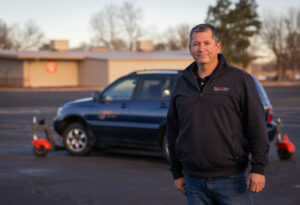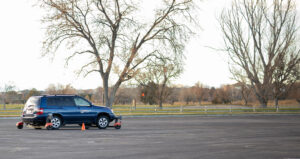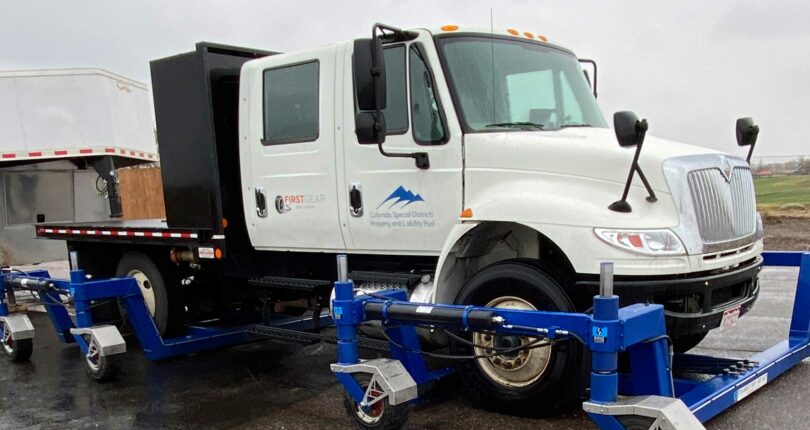Teaching electric co-op crews how to stay safe on the road
Orange traffic cones create a figure-eight track in a parking lot at the Adams County Fairground. It appears to be a rather standard driving school setup. But a 2007 navy blue Toyota Highlander SUV with an odd contraption hooked to the bottom sits in the empty lot. This is the first clue that this isn’t a typical driving school.
Distracted driving is a growing problem. According to the Colorado State Patrol, distracted driving leads to more than 15,000 crashes every year in Colorado. That’s an average of 42 crashes per day. In 2022 alone, CSP troopers investigated 600 injuries and fatal crashes attributed to distracted driving. Driver distraction — which includes eating, drinking, grooming, daydreaming, talking and texting on handheld devices, and many other actions that take a motorist’s eyes and mind off the road — is a contributing factor in many crashes, despite many instances going unreported.
It’s one man’s passion to teach people how to stay safe and stay alive while driving. As a licensed EMT, Michal Michalkow has seen it all: drivers — young and old — whose cars are wrapped around trees and power poles, flipped in ditches, or crunched in a head-on collision. “Vehicles are weapons,” he says, “and one little distraction while driving can cause someone to lose a life.” Michalkow believes every accident is preventable. For 12 years, he’s been teaching drivers how to regain control when a car loses traction on snow, ice, gravel, and standing water, or in a collision. That odd contraption on the bottom of the Highlander is a skid car attachment that simulates these conditions with the flip of a switch.

Michal Michalkow teaches skid car driving classes at the Adams County Fairground in Brighton.
During the training, a driver turns the wheel to complete the figure-eight course and midconversation and midconcentration, the SUV suddenly goes … well, the best way to describe it is “squirrely.” The skid contraption is engaged, and the Highlander fishtails and starts to spin across the empty parking lot and through the cone course. Michalkow coaches the student over blaring music. “Don’t hit my cones,” he warns. “Look where you want the car to go.” This seemingly unconventional way to teach a driver about the mechanics and physics of a skidding car is effective.
Many people don’t know what a skid car is, nor can they predict what the experience will feel like. “When Michal puts the vehicle into skid mode, it causes you to lose control of the vehicle, similar to skidding on snow, ice, or a wet ro
ad,” Empire Electric Association Safety and Compliance Administrator Jules Bitsilly said. “At first, I didn’t know what to expect. I saw YouTube videos of it, but still wasn’t sure about it.”
Bitsilly learned quickly that it has the real feeling of skidding in those conditions. “Michal was coaching me during the drive and at times it was difficult to control the vehicle,” Bitsilly said. “It was challenging to master the techniques he was trying to teach you. My arms and shoulders were tired after those maneuvers.” Michalkow says that the repetitive motions of the driving portion of the class become ingrained into a driver’s muscle memory so they can respond comfortably and not panic when they encounter a vehicle skid or collision.
Just like Bitsilly, CREA Director of Safety and Loss Control Jenna Hirsch wasn’t sure what to expect from the class. “I knew nothing about the training going into it, only that it was yet another driver’s training course,” she said. And in her career as a safety professional, she’s been through countless driving classes. The skid car experience was surprising to her. “I did worse than I anticipated,” she continued. “But by the end of the course I improved in my ability to handle some intense driving situations.”
That is a common initial response to the training. “[At first] I did worse in the skid truck than I expected. I felt confident going into it, but Michal put me in my place,” Poudre Valley REA Working Foreman Hadley Lemburg said with a laugh. “There are a lot of distractions during the driving portion of the class, and Michal keeps you on your toes, makes you think about what’s happening, and keeps it entertaining while teaching valuable skills.” Lemburg took the training, and it was his recommendation and experience at the driving school that encouraged the co-op’s safety committee to look into it.

A skid car attachment simulates a car losing traction on the road. Students learn how to regain control of a skidding car.
Linecrews typically rank in the top 10 most dangerous professions according to the U.S. Bureau of Labor Statistics, so it’s no secret they have dangerous jobs. “There are inherent risks involved in our line of work such as working with high-voltage power lines, climbing poles, inclement weather, and hazardous terrain — among others. We have safety rules and guidelines for all those typical lineworker tasks,” PVREA Vice President of Operations Ben Ludington said. “After Hadley’s recommendation, we took a step back and identified another at-risk scenario crews often face — driving to the job site.” Reporting to outages in the middle of the night on icy road conditions is understandably hazardous. But as Ludington reported, even in bumper-to-bumper traffic, driving a utility vehicle on I-25 is a high-risk task.
PVREA linecrews are not the only employees who are benefiting from the training. PVREA’s safety committee recognized an organization-wide need for enhanced driving training. “No matter if our employees work out in the field or are stationed in the office, every employee can benefit from safe driving training,” Ludington continued. “Safety is 24/7, not just when we’re at work or driving to and from the job site, but also in our personal lives when we’re with our families.” PVREA plans to put its entire workforce through the training, and it will be a part of the onboarding process for all new employees. “This training is much like teaching CPR – it has the potential to help our employees, their families, the members we serve, and the communities we live and work in.”
Hirsch agrees. “Vehicle accidents are costly — property damage, workers, compensation claims, and injuries,” she said. “Anything we can do to improve those statistics, help our employees learn to better handle tough situations, and keep our employees safe is well worth the time, money, and effort.”
“The scenarios, stories, conversation, and videos during the class really hit home and left a mark. It’s something I will remember for years to come,” Hirsch continued. “Michal’s ability to connect with students on a deep level — while keeping the classroom portion interactive and fun — was surprising.” The hands-on driving portion of the course was the best she’s encountered; she reported that it offers real-world scenarios and plenty of practice.

Michalkow sets up traffic cones in a parking lot before a driving class in the skid car.
Michalkow says that many employers and organizations are realizing the benefits of the course. “If they can prevent one incident, someone goes home alive, and the training has paid for itself,” he said.
Hirsch recommends that everyone go through this training, not just co-op crews and employees. “Put everyone in your life through it — spouses, kids, employees,” she encouraged. “Driving is one of the most important but dangerous tasks we do daily. Anything we can do to improve our performance and reaction in all scenarios is worth its weight in gold.”
For more information, visit https://firstgearskidschool.com/
Photo and story by CCL editor Kylee Coleman.

